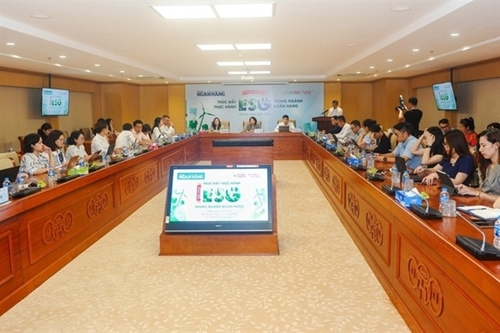At a forum on promoting ESG practices in the Vietnamese banking industry, Pham Thi Thanh Tung, Deputy Director of the SBV’s Department of Credit for Economic Sectors, said nearly 50% of banks have established a risk management division for environment protection lending.
Some banks have also issued the Green Credit Framework and the Sustainable Loan Framework to provide procedures for using and managing loan capital for projects in green and emission-reducing sectors. Many banks have so far also published separate reports on sustainable development.
    |
 |
|
View of the event (Photo dangcongsan.vn) |
As of March 31 this year, 47 banks had green outstanding loans of nearly 640 trillion VND, accounting for about 4.6% of the total outstanding loans. 34 banks reported that they conducted environmental and social risk assessments with outstanding loans of about 2.9 quadrillion VND, accounting for nearly 21% of the total outstanding loans.
According to Tung, the results of the environmental risk assessment, according to the SBV’s Circular 17/2022/TT-NHNN, show that most credit institutions have integrated environmental risk management into the credit granting and risk management process, with 35 credit institutions having issued separate environmental risk management regulations.
Banks granted credit for 110,371 projects, which implemented environmental risk management, worth nearly 991.38 trillion VND.
Despite the achievements, Dr. Pham Minh Tu, Deputy Director of the Banking Strategy Institute, said banks in Vietnam are still in the early stages of implementing ESG practices, so there are still many challenges for them to catch up.
There are currently no general national regulations on criteria and lists of green projects for sectors according to the economic sector classification system, which can be used as a basis for credit institutions to fully identify and count green credit resources. There is also a lack of specific regulations and instructions from specialized management agencies on ESG.
The capital demand for implementing the National Green Growth Strategy is very large, while capital sources to support businesses and investors from the financial market and the carbon credit market are not yet developed or implemented, causing long-term capital pressure on the banking system.
In addition, the management capacity and strategic vision on ESG of enterprises, especially SMEs, are major barriers, causing the process of transforming sustainable business models and practicing ESG in Vietnam to be difficult and affecting the efficiency of credit granting and risk management activities of credit institutions.
Sharing their experiences of ESG, Jakub Kudrna, Chief Strategy Officer and Head of ESG Steering Group of finance company Home Credit Vietnam, said the important thing is that we cannot separately build the ESG implementation plan with the business strategy of the enterprise. Practicing ESG must be an important part of the development strategy of the enterprise.
No individual or enterprise can implement sustainable development, but all industries and enterprises need to work together to create a more cohesive and sustainable environment, said Kudrna.
Source: VNA